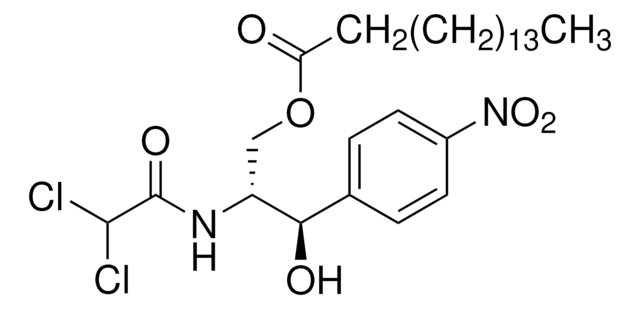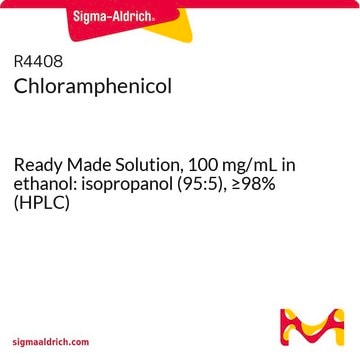C1425000
Chloramphenicol sodium succinate
European Pharmacopoeia (EP) Reference Standard
동의어(들):
Chloramphenicol succinate sodium salt, Chloramphenicol α-succinate
로그인조직 및 계약 가격 보기
모든 사진(1)
About This Item
Linear Formula:
C15H15Cl2N2O8Na
CAS Number:
Molecular Weight:
445.18
MDL number:
UNSPSC 코드:
41116107
PubChem Substance ID:
NACRES:
NA.24
추천 제품
Grade
pharmaceutical primary standard
API family
chloramphenicol
제조업체/상표
EDQM
응용 분야
pharmaceutical (small molecule)
형식
neat
SMILES string
[Na].O[C@@H]([C@@H](COC(=O)CCC(O)=O)NC(=O)C(Cl)Cl)c1ccc(cc1)N(=O)=O
InChI
1S/C15H16Cl2N2O8.Na.H/c16-14(17)15(24)18-10(7-27-12(22)6-5-11(20)21)13(23)8-1-3-9(4-2-8)19(25)26;;/h1-4,10,13-14,23H,5-7H2,(H,18,24)(H,20,21);;/t10-,13-;;/m1../s1
InChI key
RJOAHMNSYANTPN-OWVUFADGSA-N
유사한 제품을 찾으십니까? 방문 제품 비교 안내
일반 설명
This product is provided as delivered and specified by the issuing Pharmacopoeia. All information provided in support of this product, including SDS and any product information leaflets have been developed and issued under the Authority of the Issuing Pharmacopoeia. For further information and support please go to the website of the issuing Pharmacopoeia.
애플리케이션
Chloramphenicol sodium succinate EP Reference standard, intended for use in laboratory tests only as specifically prescribed in the European Pharmacopoeia.
포장
The product is delivered as supplied by the issuing Pharmacopoeia. For the current unit quantity, please visit the EDQM reference substance catalogue.
기타 정보
Sales restrictions may apply.
관련 제품
제품 번호
설명
가격
신호어
Warning
유해 및 위험 성명서
Hazard Classifications
Acute Tox. 4 Oral - Carc. 2
Storage Class Code
11 - Combustible Solids
WGK
WGK 3
Flash Point (°F)
Not applicable
Flash Point (°C)
Not applicable
가장 최신 버전 중 하나를 선택하세요:
J A Turton et al.
International journal of experimental pathology, 83(5), 225-238 (2003-03-19)
In man, chloramphenicol (CAP), induces two major haemotoxic effects. First, a reversible, dose-related reticulocytopenia and anaemia developing during treatment. Second, a non-dose-related aplastic anaemia (AA), developing weeks after treatment, is often irreversible and fatal. In previous studies, we developed a
M F Festing et al.
Food and chemical toxicology : an international journal published for the British Industrial Biological Research Association, 39(4), 375-383 (2001-04-11)
Much toxicological research continues to be done using genetically undefined "outbred" stocks of mice and rats, although the case for using isogenic strains has been made repeatedly in the literature over a period of more than two decades. Also, very
C S Ambekar et al.
European journal of clinical pharmacology, 56(5), 405-409 (2000-09-29)
The metabolism of chloramphenicol succinate (CAPS) by human bone marrow was studied in vitro using 75 marrow samples. Whole marrow samples were incubated with CAPS with or without reduced nicotinamide adenine dinucleotide phosphate for 1, 2 and 3 h at
Roberta A Gottlieb et al.
Autophagy, 7(4), 434-435 (2010-12-29)
Interventions that reduce infarct size in animal models have largely failed to improve outcome in patients suffering acute myocardial infarction (MI), or 'heart attack'. Our group recently reported a reduction of infarct size by chloramphenicol treatment in a porcine in
Karin Przyklenk et al.
Autophagy, 7(4), 432-433 (2010-12-29)
There is no question that necrosis and apoptosis contribute to cardiomyocyte death in the setting of myocardial ischemia-reperfusion. Indeed, considerable effort and resources have been invested in the development of novel therapies aimed at attenuating necrotic and apoptotic cell death
자사의 과학자팀은 생명 과학, 재료 과학, 화학 합성, 크로마토그래피, 분석 및 기타 많은 영역을 포함한 모든 과학 분야에 경험이 있습니다..
고객지원팀으로 연락바랍니다.






